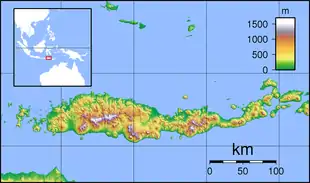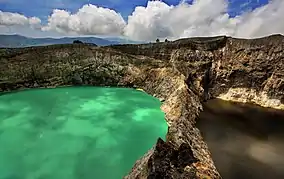Kelimutu
Kelimutu (pronounced [kəliˈmutu]) is a volcano, close to the small town of Moni in central Flores island in Indonesia. It is around 50 km (31 mi) to the east of Ende, Indonesia, the capital of Ende regency in East Nusa Tenggara province. It has three volcanic crater lakes that differ in color.
| Kelimutu | |
|---|---|
 | |
| Highest point | |
| Elevation | 1,639 m (5,377 ft) [1] |
| Listing | List of volcanoes in Indonesia Spesial Ribu |
| Coordinates | 8°46′S 121°49′E |
| Geography | |
 Kelimutu Kelimutu | |
| Location | Ende Regency, Flores Island, Indonesia |
| Geology | |
| Mountain type | Complex volcano |
| Last eruption | June to July 1968[1] |

The science of the Kelimutu lakes is relatively well-known.[2] Lake colors periodically change due to adjustments in the oxidation-reduction status of the fluid of each lake, and also considering the abundance of different major elements, such as iron and manganese. Oxidation-reduction status depends on the balance of volcanic gas input and rainfall rate,[3] and is thought to be mediated by the groundwater system in the volcano itself.[4] The colors in the lakes change independently from each other, as each has its own unique connectivity to the underlying volcano's activity. Between January and November 2016, the colors of the craters changed six times.[5] Although it is widely believed that the changes are unpredictable, it is more accurate to say that the lack of any regular monitoring of the volcanic system precludes scientists from having the data necessary to drive widely available predictive models.
Geological details
The volcano contains three striking summit crater lakes of varying colors. Tiwu Ata Bupu (Lake of Old People) is usually blue and is the westernmost of the three lakes. The other two lakes, Tiwu Ko'o Fai Nuwa Muri (Lake of Young Men and Maidens) and Tiwu Ata Polo (Bewitched or Enchanted Lake) are separated by a shared crater wall and are typically green or red respectively. The lake colors vary on a periodic basis. Subaqueous fumaroles are the probable cause of active upwelling that occurs at the two eastern lakes.[1]
The lakes have been a source of minor phreatic eruptions in historical time. The summit of the compound 1,639 m (5,377 ft) high Kelimutu volcano is elongated 2 km (1.2 mi) in a WNW-ESE direction; the older cones of Kelido and Kelibara are located respectively 3 km (1.9 mi) to the north and 2 km (1.2 mi) to the south. The scenic lakes are a popular tourist destination.[6]
Kelimutu is also of interest to geologists, because the three lakes have different colors, yet are at the crest of the same volcano.[7] According to Kelimutu National Park officials, the colour changes as a result of chemical reactions resulting from the minerals contained in the lake perhaps triggered by volcano gas activity.[8] However, it is more accurate to refer to the color changes as being driven by oxidation-reduction chemical dynamics. Kawah Putih lake in West Java, south of Bandung, is another crater lake in Indonesia with some similarities to the lakes at Kelimutu.
Tourism
In the early days of developing the local national park in the Kelimutu area, there were some disputes with local communities over the use of the resources. More recently, forest rangers have worked to develop better relations with nearby village communities and overall management has improved.[9]
Kelimutu is one of the mountains listed as a ribu in Indonesia which are mountains in Indonesia which are more than 1,000 metres (3,281 ft) high.
The area is said to have begun to attract attention after being noticed by a regional Dutch military commander, B. van Suchtelen in 1915 and became more well known after Y. Bouman wrote about the site in 1929.[10]
The closest airports are Maumere, and Ende. There are regular flights to Ende from Bali. The drive from Ende to Moni, the town at the base of Kelimutu where accommodation is available, takes about 3 hours, while from Moni to Kelimutu vehicle park, a 13 kilometres (8.1 mi) drive, needs 45 minutes.[11] Usually tourists sleep one night to catch sunrise at Kelimutu.
Gallery
 A panoramic view of all three lakes at Kelimutu, from left to right: Tiwu Ko'o Fai Nuwa Muri, Tiwu Ata Polo (behind Tiwu Ko'o Fai Nuwa Muri), and Tiwu Ata Bupu (black lake on far right)
A panoramic view of all three lakes at Kelimutu, from left to right: Tiwu Ko'o Fai Nuwa Muri, Tiwu Ata Polo (behind Tiwu Ko'o Fai Nuwa Muri), and Tiwu Ata Bupu (black lake on far right) The twin lakes of Tiwu Ko'o Fai Nuwa Muri (Lake of Young Men and Maidens) and Tiwu Ata Polo (Bewitched, or Enchanted Lake)
The twin lakes of Tiwu Ko'o Fai Nuwa Muri (Lake of Young Men and Maidens) and Tiwu Ata Polo (Bewitched, or Enchanted Lake) Tiwu Ko'o Fai Nuwa Muri and Tiwu Ata Polo
Tiwu Ko'o Fai Nuwa Muri and Tiwu Ata Polo Tiwu Ko'o Fai Nuwa Muri and Tiwu Ata Polo
Tiwu Ko'o Fai Nuwa Muri and Tiwu Ata Polo Tiwu Ata Bupu (Lake of Old People)
Tiwu Ata Bupu (Lake of Old People)
References
- "Kelimutu". Global Volcanism Program. Smithsonian Institution.
- "Dr. Gregory B. Pasternack - Watershed Hydrology, Geomorphology, and Ecohydraulics :: Keli Mutu". pasternack.ucdavis.edu. Retrieved 2017-06-11.
- Pasternack, Gregory B.; Varekamp, Johan C. (1997-05-01). "Volcanic lake systematics I. Physical constraints". Bulletin of Volcanology. 58 (7): 528–538. doi:10.1007/s004450050160. ISSN 0258-8900.
- Pasternack, G. B. 1993. Acid-brine crater lake systematics: a case study. Undergraduate High Honors thesis. Wesleyan University, 160 pp, 4 appendices. DOI: 10.13140/RG.2.1.3414.1040.
- Markus Makur (November 24, 2016). "Kelimutu lakes change color for the 6th time this year".
- 'Kelimutu: Adventure to the Three coloured lakes', Accessed 29 April 2012.
- Pasternack, Gregory B.; Johan C. Varekamp (1994). "The geochemistry of the Keli Mutu crater lakes, Flores, Indonesia" (PDF). Geochemical Journal. 28 (3): 243–262. doi:10.2343/geochemj.28.243. Here's a link to the abstract
- Some details of the characteristics of volcanic soils in the area can be found at Hikmatullah, H. Subagyo, and B.H. Prasetyo, 'Soil properties of the eastern toposequence of Mount Kelimutu, Flores Island, East Nusa Tenggara and their potential for agricultural use', Indonesian Jour. of Agricultural Science, 4(1), 2003, pp. 1-11.
- Tifa Asrianti, 'Locals help protect Kelimutu national park', The Jakarta Post, 4 January 2011.
- Gagas Ulung (2011), Exotic NTT: 200 tempat paling menantang dan eksotis di provinsi Nusa Tenggara Timur: wisata alam, bahari, budaya, dan tradisi [Exotic NTT: 200 of the most challenging and exotic places in Nusa Tenggara Timur: tourism for nature, the sea, culture, and tradition], PT Gramedia Pustaka Utama, Jakarta, p. 184.
- Tri Hatma Ningsih (June 23, 2014). "Tiga Warna Sejuta Pesona".
External links
| Wikimedia Commons has media related to Kelimutu. |
 Kelimutu travel guide from Wikivoyage
Kelimutu travel guide from Wikivoyage- Volume 28, No. 3, pp. 137-306 of the Geochemical Journal is a special issue of the journal dedicated to Volcanic lakes.
